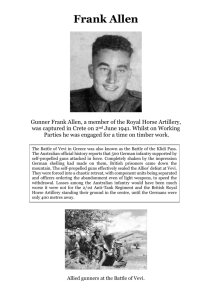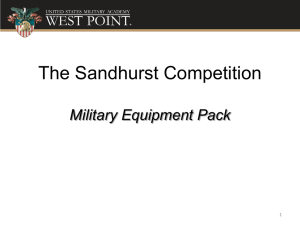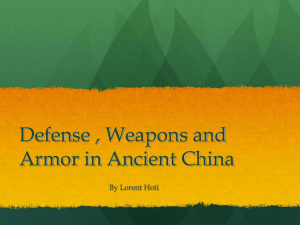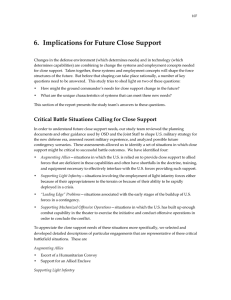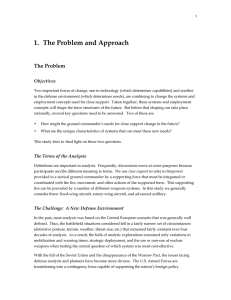Figures
advertisement
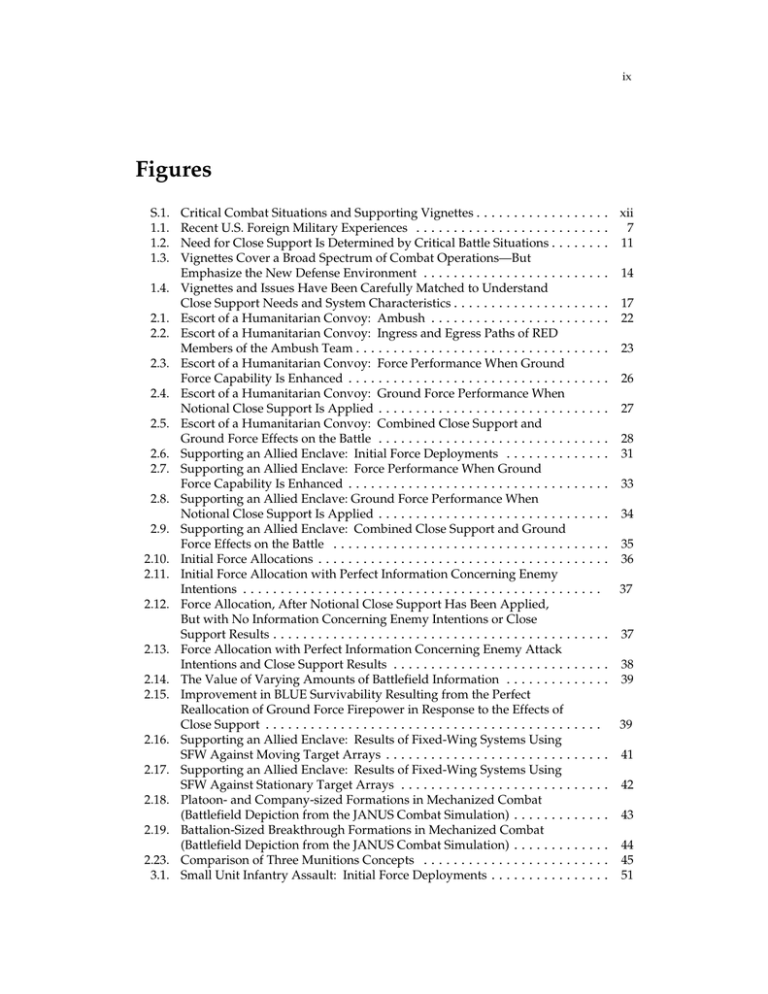
ix Figures S.1. 1.1. 1.2. 1.3. 1.4. 2.1. 2.2. 2.3. 2.4. 2.5. 2.6. 2.7. 2.8. 2.9. 2.10. 2.11. 2.12. 2.13. 2.14. 2.15. 2.16. 2.17. 2.18. 2.19. 2.23. 3.1. Critical Combat Situations and Supporting Vignettes.................. Recent U.S. Foreign Military Experiences .......................... Need for Close Support Is Determined by Critical Battle Situations........ Vignettes Cover a Broad Spectrum of Combat Operations—But Emphasize the New Defense Environment ......................... Vignettes and Issues Have Been Carefully Matched to Understand Close Support Needs and System Characteristics..................... Escort of a Humanitarian Convoy: Ambush ........................ Escort of a Humanitarian Convoy: Ingress and Egress Paths of RED Members of the Ambush Team.................................. Escort of a Humanitarian Convoy: Force Performance When Ground Force Capability Is Enhanced ................................... Escort of a Humanitarian Convoy: Ground Force Performance When Notional Close Support Is Applied ............................... Escort of a Humanitarian Convoy: Combined Close Support and Ground Force Effects on the Battle ............................... Supporting an Allied Enclave: Initial Force Deployments .............. Supporting an Allied Enclave: Force Performance When Ground Force Capability Is Enhanced ................................... Supporting an Allied Enclave: Ground Force Performance When Notional Close Support Is Applied ............................... Supporting an Allied Enclave: Combined Close Support and Ground Force Effects on the Battle ..................................... Initial Force Allocations ....................................... Initial Force Allocation with Perfect Information Concerning Enemy Intentions ................................................ Force Allocation, After Notional Close Support Has Been Applied, But with No Information Concerning Enemy Intentions or Close Support Results ............................................. Force Allocation with Perfect Information Concerning Enemy Attack Intentions and Close Support Results ............................. The Value of Varying Amounts of Battlefield Information .............. Improvement in BLUE Survivability Resulting from the Perfect Reallocation of Ground Force Firepower in Response to the Effects of Close Support ............................................. Supporting an Allied Enclave: Results of Fixed-Wing Systems Using SFW Against Moving Target Arrays .............................. Supporting an Allied Enclave: Results of Fixed-Wing Systems Using SFW Against Stationary Target Arrays ............................ Platoon- and Company-sized Formations in Mechanized Combat (Battlefield Depiction from the JANUS Combat Simulation) ............. Battalion-Sized Breakthrough Formations in Mechanized Combat (Battlefield Depiction from the JANUS Combat Simulation) ............. Comparison of Three Munitions Concepts ......................... Small Unit Infantry Assault: Initial Force Deployments ................ xii 7 11 14 17 22 23 26 27 28 31 33 34 35 36 37 37 38 39 39 41 42 43 44 45 51 x 3.2. Small Unit Infantry Assault: Force Performance When Ground Force Capability Is Enhanced ...................................... 3.3. Small Unit Infantry Assault: Ground Force Performance When Notional Close Support Is Applied .............................. 3.4. Small Unit Infantry Assault: Combined Close Support and Ground Force Effects on the Battle .................................... 3.5. Small Unit Infantry Assault: Results of Joint Assets Providing Close Support.................................................. 3.6. Small Unit Infantry Patrol: Urban Environment .................... 3.7. Small Unit Infantry Patrol: RED Ambush Positions and Initial BLUE Patrol Positions ............................................ 3.8. Small Unit Infantry Patrol: Force Performance When Ground Force Capability Is Enhanced ...................................... 3.9. Small Unit Infantry Patrol: Ground Force Performance When Notional Close Support Is Applied .............................. 3.10. Small Unit Infantry Patrol: Combined Close Support and Ground Force Effects on the Battle .................................... 4.1. Hasty Defense by Light Forces: Initial Force Deployments ............ 4.2. Hasty Defense by Light Forces: Force Performance with General Ground Force Upgrades...................................... 4.3. Hasty Defense by Light Forces: Ground Force Performance When Notional Close Support Is Applied .............................. 4.4. Hasty Defense by Light Forces: Combined Close Support and Ground Force Effects on the Battle .............................. 4.5. Prepared Defense by Light Forces: Initial Force Deployments .......... 4.6. Prepared Defense by Light Forces: Force Performance When Ground Force Capability Is Enhanced .................................. 4.7. Prepared Defense by Light Forces: Ground Force Performance When Notional Close Support Is Applied .............................. 4.8. Prepared Defense by Light Forces: Combined Close Support and Ground Force Effects on the Battle .............................. 4.9. A Comparison of Munitions Footprints........................... 4.10. MLRS Lethality: Approximate Single Rocket Area of Coverage Comparisons to Target Size ................................... 4.11. Prepared Defense by Light Forces: Adaptive Targeting of Close Support Systems ........................................... 5.1. Armored Force Meeting Engagement: Initial Force Deployments ........ 5.2. Armored Force Meeting Engagement: Force Performance When Ground Force Capability Is Enhanced ............................ 5.3. Armored Force Meeting Engagement: Ground Force Performance When Notional Close Support Is Applied ......................... 5.4. Armored Force Meeting Engagement: Combined Close Support and Ground Force Effects on the Battle .............................. 5.5. Armored Force Meeting Engagement: JANUS Results, Fixed-WingDelivered SFWs............................................ 5.6. Armored Force Meeting Engagement: JANUS Results, Fixed-WingDelivered Maverick Missile Engagement Profile .................... 5.7. Armored Force Meeting Engagement: Advanced Artillery Employment .............................................. 6.1. Needs for Close Support in Different Battle Situations ................ 6.2. Desirable System Characteristics Depend on the Battle Situation ........ 53 54 55 56 58 59 61 62 63 71 73 74 75 81 83 84 85 86 87 88 94 97 98 98 100 101 102 109 115 xi A.1. A.2. A.3. A.4. How Each Scenario Rates as to Nuclear Weapons ................... How Each Scenario Rates as to Biological Weapons .................. How Each Scenario Rates as to Chemical Weapons .................. Summary of Delphi Assessments ............................... 132 133 134 135
